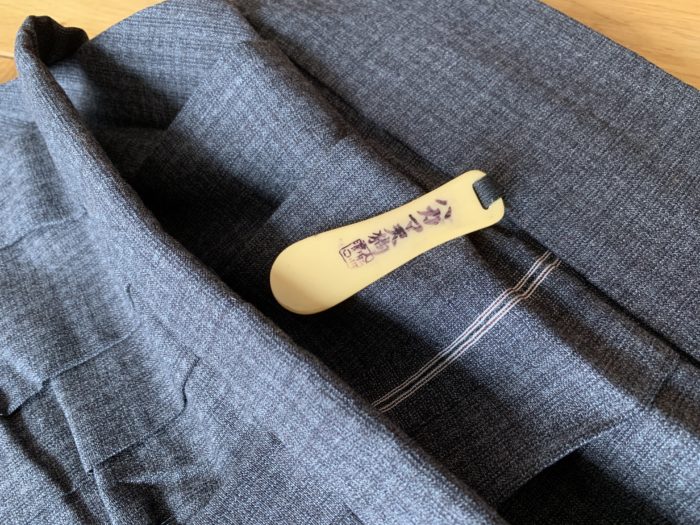What is a little surprising for us is that Westerners have a strong interest in Kimono hakama which is similar to skirts. However, the type of Hakama differs depending on whether it is purely kimono fashion, for men or women, and for martial arts such as kendo and aikido. It is difficult for us to explain, but we would like to explain with photos and videos. But our thinking is the same here. “You don’t have to be serious about authentic wearing. Enjoy your own fashion with your own ideas.”
I would like to quote photos from the magazine “Utsukushii Kimono(Beautiful Kimono)” Fall 2009 issue.The man on the right is wearing a long kimono, haori, and hakama.

During the Edo period (17th c – mid 19th c), the haori and hakama is a formal dress of samurai. I would like to quote 3 images from the catalog “Kimono:Kyoto to Catwalk” (2020) by the Victoria and Albert Museum in London.



The Meisen kimono , haori and Hakama skirt for young women became a typical image of the girls student style in the Taisho era (1912 – 1926). Since the haori and hakama style was formal style of samurai since the 17th c, the style of women’s hakama disappeared after the 17th c. However, It revived as formal wear for female students in the mid-19th century. It can be said that young women became to receive higher education, so uniforms were needed in schools’ formal world.


The photo on the left is a formal dress of a female student estimated to be in the 1930s. It was left in a textile factory where Meisen kimonos were mass-produced. She wears a hakama that can reach the chest of a fancy flower-printed Meisen kimono. On the right is an illustration from a magazine of the same age. However, this style disappeared with the spread of clothes after World War II.
Interestingly, women’s hakama style revived in the 1980’s as a graduation ceremony fashion for women’s college students.One of the triggers is probably a girl manga or comic ,“Haikara san ga toru” set in the Taisho era(see below 1st pic).It was isued in the 1970s, comics totaled more than 12 million copies, became animated, cinema and a musical of Takarazuka (musical theater company only by young women).

For young women of today, this style is a one-time ceremony outfit at the college graduation, as same as the frisode worn at the coming-of-age ceremony and the bride kimono worn at the wedding. For the graduate season in May, many young women rent and wear it with Frisode.
Let’s introduce two kinds of Hakama styles from the website of the major kimono maker Mimatsu. The woman on the left is wearing Japanese sandals and is conventional. On the other hand, the right is Western wearing boots, which is the style that the comic made popular.


Standard length from cord knot to ankle is as follows.
height 160-170cm ; 95cm
height 170-175cm ; 99cm
However, if you wear boots, it may be better to be a little shorter. In other words, even if a hakama is short, it becomes a wonderful fashion in combination with boots. The waist size is adjusted with a cord, so you don’t have to worry about it. Please refer to the following video for how to wear it.
Be aware of the important differences between men and women. The left is for men. There is a hip plate. In contrast, the right woman has no hip plate.


Finally, let’s introduce an event in Kyoto where you can see beatiful young women’s hakama style.The Sanjusangendo archery contest. Seasoned archers and new 20-year-olds all gather to celebrate and compete by firing the first arrows of the New Year.
